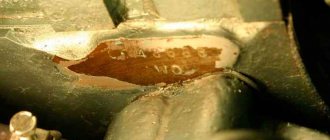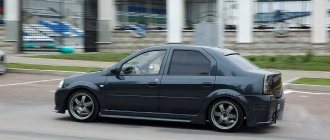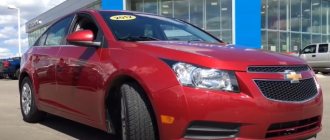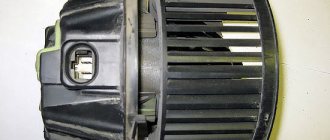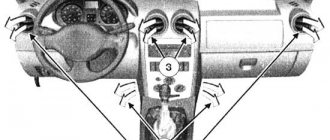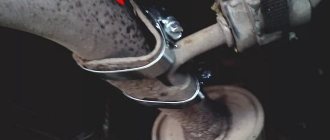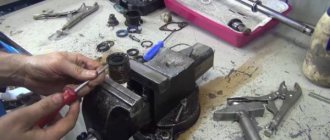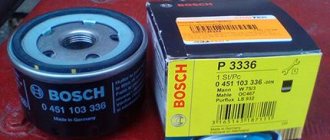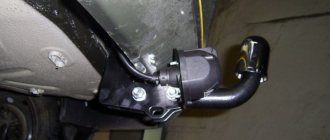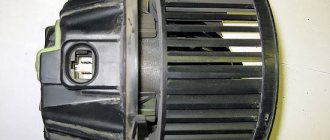How to find out the engine number?
Engine number nearby
Because the numbers and letters on the power unit do not necessarily tell you what exactly is encrypted there. For this purpose you need to use a hint.
The first line contains an alphanumeric index consisting of 7 characters. The first three characters indicate the type of engine, while the others indicate the number of valves, volume and injection system.
Under this line there is a seven-digit index, which will be the specific number of this specific instance of the motor. It must be used for recording in warranty documents.
When cleaning the engine number, do not use iron brushes.
Be careful. Do not use iron brushes when “cleaning” the engine number. You should use only rust removers, such as Tsinkar, or analogues when the Logan body is galvanized.
The more than just the mileage of the engine, the more terrible it will be seen and the more difficult it is to make out the numbers; it’s great that the Traffic Police does not currently ask to check the number of this element when registering.
Engine design features
Engine design K7J (manufacturer Automobile Dacia, Romania) 1. 4 l/75 l. With.
inherited from fairly old Renault Corporation engines developed in the 80s (ExJ series) and therefore looks somewhat archaic: there is an unusual chain drive for the oil pump, used on units with lower camshafts, and ancient timing rocker arms. Other engine solutions 1.
4 are standard and no different from other four-stroke 4-cylinder single-shaft SOHC engines: cylinder arrangement is in-line vertical, 2 valves per cylinder, timing belt drive, liquid cooling and a combined lubrication system (lubricant is supplied to the most loaded parts of the internal combustion engine under pressure, to all others - by simple spraying).
K7J has more than 400 thousand kilometers. Motor 1.
Engine Renault Logan K7M 710 and its successor K7M 800 (produced by the same Automobile Dacia) 1.6 l and 86 hp. (K7M 800 - 82 hp) are almost completely identical in design to the K7J, they are also liquid cooled, but have a piston stroke increased by 10.5 mm, obtained by changing the height of the block.
The greatest differences in design and characteristics are observed in the K4M engine, despite the fact that this internal combustion engine has 1.6 l and 102 l. With.
is also just another development of the K7M series. An all-new 16-valve cylinder head with two lightweight camshafts and a new piston system. Here, finally, the need for constant adjustment of internal combustion engine valves over fairly short runs has been eliminated, eliminated by the simple use of well-known hydraulic compensators.
The engine accelerates the car to 100 km/h in 10.5 seconds, reaching a maximum of 180 km - quite good performance. There are no obvious weak points in this unit: the necessary changes have been made to the system in terms of the pump and thermostat, and the ignition module has also been modified.
One of the most popular K7J power units, produced by the Romanian division of the company, is equipped with a significant part of the cars.
K7J engine for Renault Logan 2006. One of the most widely installed engines on this model.
If you look closely, you can see in the K7J some features characteristic of the ExJ series, produced by Renault in the eighties of the last century. Such “archaisms” include the chain drive of the oil pump, old types of timing rocker arms, as well as the method of placing some parts. Other solutions for the 1.4-liter engine are practically no different from other single-shaft engines from the SOHC family.
This is the same in-line arrangement of cylinders in a vertical layout, the presence of two valves per cylinder, as well as a combined lubrication supply system. However, all this does not diminish the advantages of the engine, which is capable of operating without “capital” for about four hundred thousand kilometers. At the same time, Renault Logan with this power unit can accelerate to “hundreds” in thirteen seconds, maintaining a maximum speed of 162 kilometers per hour.
VIN code location
In addition to the VIN code, it is necessary to record other data about the car. If possible, do this on several cardboard media so that you can always find the information you are interested in. This will help in choosing a product and purchasing the right part.
The VIN code indicates the model of the engine installed on the car.
Passport data is located on a special identification plate. The location of its fixation is located on the right pillar of the front passenger door.
As for the identification number, which can also be called a VIN code, it is located on the dashboard of the engine department
You can find it, of course, by simply opening the hood. Right in front of your eyes, closer to the car’s interior, you will see a gray plate stretched horizontally.
Malfunctions and repairs
Like all Renault engines, the K7M has problems and typical malfunctions:
- Failure of sensors: IAC, DKPV, DMRV. The problem can be resolved by replacing the elements.
- The vibration is caused by wear on the right pad.
- Overheat. It's usually the thermostat or water pump.
- Troubles the K7M engine. In this case, the malfunction should be looked for in the elements of the process of formation of the air-fuel mixture.
- Knock. A loud metallic noise in the engine compartment means it's time to adjust the valves.
Renault Logan 2 – Engine number K4M, K7M, H4M
However, the main problem lies under the hood. Owners of previous Logans know how easily and quickly engine numbers rot on their engines. In 3-4 years, the symbols could not only become covered with a coating of corrosion, but disappear forever without a trace, so that neither WD-40 nor zinc lotions could help. The second generation did not lose this drawback, but the rate of destruction clearly decreased sharply. It is especially dangerous to clean the markings with sandpaper. Let me remind you that the law contains an article for the deliberate destruction of forensic markings. Fortunately, the new amendments allow you to re-register a car with a rotten license plate. Not without unnecessary movements, of course, but it’s possible.
On the K4M (1.6, 103 hp) and K7M (1.6, 82 hp) Logan 2 power plants, the engine number is located in almost the same place: in the front of the unit, under the manifold, closer to the gearbox. In the case of a 16-valve unit, it is extremely difficult to establish visual contact with the platform, even with an inspection mirror. In order to clean the symbols from rust, you will have to completely dismantle part of the air duct, otherwise a hand with a rag will not fit through.
Engine number K7M (1.6, 82 hp) Engine number K4M (1.6, 103 hp)
The only engine with which there will definitely be no problems with corrosion and dirt is the Nissan H4M unit (113 hp). The engine number on it is printed vertically on an inclined platform in the front of the engine close to the gearbox:
Engine number HR16DE-H4M (113 hp)
Renault Logan 2 – Weaknesses and breakdowns
Advantages and disadvantages of power units
The 1.6 and 16-valve engine differs from the newest modifications; they are the absence of a mechanism for regulating valve timing; this engine design has significantly reduced the dynamic capabilities of the car.
But the advantages remain excellent maintainability and durability, that is, increased engine life, thanks to simple design solutions from the manufacturer. The engine is powered by a 1.4-liter 8-valve engine, which confirms the identical layout and similar design aspects of both engines. The changes affected the following components and systems:
- the cylinder volume increased (1.6 liter engine), which made it possible to increase power in tandem with torque and improve the dynamic characteristics of the model;
- The output of the unit increased by 11% (up to 82 “horses” for the 8-valve version), this engine design led to an increase in torque to 132 Nm;
- the cooling system has undergone adjustments (the need for this modification is caused by an increase in engine power);
- the cooling circuit did not receive any fundamental design changes, and its elements were modified in order to achieve greater performance, for which some new components were integrated, which led to an increase in the service life and efficiency of the system, especially in critical operating modes;
- power increase up to 102 hp. With. achieved thanks to the use of new components in the cylinder-piston group units and valve mechanism:
- the number of valves has doubled (from 8 to 16), which ensured better filling of the combustion chambers with the mixture and led to an increase in power and dynamic capabilities;
- The service life of the motor has increased significantly due to the use of parts made of new, more durable alloys;
- After applying the previously mentioned design solutions in the updated engines, Renault Logan developers managed to achieve significant fuel efficiency:
- 1.5 liters at a distance of 100 km for a 1.6 engine with 16 valves;
- 1.0 liter in the case of 8-valve engine versions.
All these innovations made it possible to essentially make the 1.6 liter engine. more modern (especially the 16-valve version), the engine life has become longer. Although the developers did not apply progressive and innovative design solutions, this modernization of engines for Renault Logan still made it possible to attract a large army of new potential customers to the updated model.
- increasing the performance level of the intake and exhaust systems, which was a necessary measure to bring engines to the advanced level of environmental standards;
- the use of new elements in the cooling circuit, which significantly improved the efficiency of its operation;
- replacement of the generator with a version of increased performance for the Renault Logan model, which made it possible to cope with increased loads on this unit (now the power varies depending on the model’s configuration)
Considerable experience in operating Renault cars with all three types of liquid-cooled engines allows us to draw up a fairly objective picture of their strengths and weaknesses, and in the two models K7J and K7M these characteristics are almost identical, and only the K4M engine has significant differences due to more modern technological solutions, and which one is better is up to the buyers to decide.
Advantages of K7J and K7M:
- low cost and simplicity of engine design;
- reliability: confirmed service life is more than 400 thousand km;
- versatility and maintainability;
- ease of maintenance;
- high torque;
- good “elasticity” of engines, equal to 1.83.
Disadvantages of K7J and K7M:
- relatively high fuel consumption;
- instability of speed when idling;
- the absence of hydraulic compensators in the design, as a result - the need for constant adjustment of the valves (after 20-30 thousand km);
- “bending” of valves when the timing belt suddenly breaks;
- increased “fluidity” of crankshaft oil seals;
- poor reliability of cooling system elements;
- noisy and prone to vibration.
The advantages of the K7M model over the K7J include only an increase in maximum power by 12% and maximum torque by 11%. But the 1.6 liter internal combustion engine also pays for these advantages with an increased appetite of 4.5%, so which is better is a moot point.
Advantages of K4M:
- reliability, practical service life exceeds 400 thousand km;
- compliance with Euro-4 environmental standards;
- increased power (102 hp);
- low noise and vibration resistance;
- more modern and reliable cooling system.
Compared to 8-valve engines, the K4M 16V is much quieter, vibration-free and has the same service life, but significantly more power and torque. Disadvantages of the K4M motor:
- expensive spare parts;
- “bending” of valves when the belt breaks;
- weak “elasticity” of the engine, equal to 1.53, as a result – problems with car acceleration when overtaking.
Thus, a detailed analysis of the technical characteristics of all three ICE samples, as well as practical experience in operating Renault Logan with these power plants, allows us to determine which engine is better. The more powerful 1.6 liter internal combustion engine with liquid cooling is still somewhat preferable to its “big brother” 1.
4 l. Power 75 l. With.
It’s simply not enough for comfortable driving of a loaded car, either on a country highway or during short “jogs” around the city. And in the debate between a 16V motor and an 8V motor, the first sample is the undisputed leader. The only characteristic in which 16V is inferior to its opponent is “elasticity”.
For other characteristics, 16V is better. Renault's liquid-cooled V16 engine is simply much more modern and gives the driver more options.
https://www.youtube.com/watch?v=JOLI8B_ug1U
All engines of the Logan model, in accordance with the manufacturer's instructions, must be refueled with 95-grade gasoline, and what kind of gasoline do you use?
The engines used on the machines also played a significant role in this. These are power units that have stood the test of time and have proven themselves in other cars of the concern. In particular, we are talking about eight-valve engines of the K7J and K7M series with a volume of 1.4 and 1.6 liters, respectively.
Thus, a detailed analysis of the technical characteristics of all three ICE samples, as well as practical experience in operating Renault Logan with these power plants, allows us to determine which engine is better. The more powerful Renault Logan 2 1.6 liter liquid-cooled engine is still somewhat preferable to its “big brother” 1.4 liter. Power 75 hp It’s simply not enough for comfortable driving of a loaded car, either on a country highway or during short “jogs” around the city.
And in the debate between a 16V motor and an 8V motor, the first sample is the undisputed leader. The only characteristic in which 16V is inferior to its opponent is “elasticity”. For other characteristics, 16V is better. Renault's liquid-cooled V16 engine is simply much more modern and gives the driver more options.
We recently looked at three problematic engines from the French automaker. And today we’ll talk about the real long-livers among Renault engines.
Currently reading: Logan crashes when cold - Auto magazine Akord-Auto
VIN code location
In addition to the VIN code, you also need to record other data about the car. If possible, do this on several paper media so that you can always find the information you are interested in. This will help in choosing and purchasing the right part.
By VIN code you can find out the model of the engine installed on the car
Passport data is located on a special identification plate. The location of its fixation is located on the right pillar of the front passenger door.
As for the identification number, which can also be called a VIN code, it is located on the engine compartment panel
You can find it by simply opening the hood. Directly in front of your eyes, closer to the car interior, you will see a light gray plate, elongated horizontally.
What does the information on the signs mean?
Vehicle identification data
If we talk about the first information plate (which is circled in an oval), then it contains data that will help in finding parts.
| Below this sign is another sticker. If you read it from top to bottom, you can see:
|
By the engine number you can determine whether it has been replaced or repaired. Such a request can be sent through any Renault dealership. Upon request, you can find out whether the engine has undergone a major overhaul, for example, due to wear or bent valves.
Renault Logan paint code
The encrypted Renault Logan paint code is placed on the plate where the VIN is indicated. As a rule, it is mounted at the bottom of the door pillar on the front passenger side. The shade marking consists of four or five characters, which are stamped in a column on the left side in the third line . The first two characters contain information about the type of paint:
- OV – classic plain and opaque;
- NV – mother-of-pearl;
- MV – metallized;
- TE – specific.
The remaining two or three symbols directly indicate the color scheme. They can be made in alphabetic or digital form.
Logan 2 paint code
Logan paint codes from 2011
The Renault Logan 2nd generation uses the following paint codes indicating the color markings:
- NV 676 (7701422417) – Perle noire;
- OV 369 (7711143324) – Glace blanche;
- TE B76 (7711213274) – Rouge;
- TE D69 (7711222354) – Platinum grise;
- TE RPL (7711576322) – Bleu Azur;
- TE KNM (7711573071) – Basalte léger;
- TE RPG – Saphir bleu.
Logan color code 1
Paint codes with decoding for Renault Logan first generation:
- 369 – white ice;
- 472 – blue twilight;
- 632 – shimmering platinum;
- 676 – black mother-of-pearl, black pearls;
- 21B – red bullfighter;
- 61G – Aegean Sea;
- B66 – gray;
- D69 – platinum gray;
- F98 – green opaline;
- J48 – sea blue;
- KNA – gray comet;
- KNM – basalt gray;
- RNF – blue mineral;
- RNZ - electric blue.
Components of the code
This cipher consists of 17 characters, including Latin letters and Arabic numerals. But there are three exceptions, these include the symbols “I”, “O”, “Q”. Why are these letters not involved in the formation of the VIN code? The answer to this question is very simple. The characters “O” and “Q” themselves are very easy to confuse with “0”. Yes, and correcting “O” and “0” to “Q” is not at all difficult. The same applies to the letter “I”, which is not only easy to confuse with “1”, but also easy to correct, for example, by making “L”, “F”, “E” or some other symbol. Therefore, to make life more difficult for scammers, these letters were excluded.
The VIN structure can be divided into three main parts. It all starts with WMI, which consists of the first three characters. This part characterizes the vehicle manufacturer. Having deciphered the first character, you will find out in which geographical area the car was produced; the second character hides more specific information, namely the country. The third character will already provide information about a specific manufacturer. In some cases, you can see the number “9” in the last position of the WMI part, this means that less than 500 cars are produced per year. But information about the manufacturer will then be hidden behind signs 12–14.
Decoding Renault VIN code
Next is the VDS group, it includes six characters. Typically, this part of the code provides information about the characteristics of the vehicle - body type, model range, equipment, etc. Sometimes the gross vehicle weight and safety systems may even be indicated. The 9th position of the VIN, where the control number is hidden, deserves special attention. If fraudsters have a small chance to fake the remaining symbols, then during verification this particular number will not confirm the authenticity of the marking.
The last, closing group is called VIS. It includes 8 designations. After reading them, you can find out about the model year of the car, especially for the American manufacturer. In general, this information is of a very individual nature, for example, for most cars produced in the USA, the 10th position indicates the next model year, starting from July 1. This has a completely logical explanation, because many cars first go to the exhibition, and only next year for sale. Thus, with the onset of the new calendar year, there are no “last year’s” products left in the warehouse. But it is worth noting that many manufacturers may not be clever with numbers and indicate the actual year of manufacture.
Let's sum it up
The considered power units with 8 or 16 valves are traditional for the French manufacturer of all models, including Renault Logan, and are unpretentious in operation and wear-resistant. In terms of dynamic characteristics, these engines are not “sports”, but they will not allow the owner to lag behind heavy traffic on the road.
Their reviews are very, very positive. There were cases when engines failed after driving 100 thousand km due to defects in the crankshaft liners, but these precedents were not widespread.
Budget car models Renault Logan 1.4 and Logan 1.6, over the almost ten-year history of their presence on Russian roads, have managed to win the recognition of many thousands of car enthusiasts.
The concept of the French manufacturer, which decided back in 1998 to create an inexpensive and practical passenger car intended for developing markets, received the most triumphant continuation and unexpected development in Russia. If in 2005 it all began at a small site of the Avtoframos enterprise in Moscow with the “screwdriver” assembly of several thousand cars per month, then today the Volzhsky Automobile Plant is building its annual plans, relying on the whole “Loganov” model scattering: Renault Logan, Renault Sandero, Lada Largus. Sales of these three models in the country in 2014 exceeded 160 thousand units.
To a large extent, such popularity of these Renault models was ensured by the use of proven and well-proven 8V single-shaft internal combustion engines (ICE) of the K7J 1.4 l and K7M 1.6 l series as power units.
The flagship of the line for Renault Logan is considered to be a 16V four-cylinder liquid cooling unit with the index K4M, the production of which, in addition to the parent company Renault Espana, is also mastered at AvtoVAZ production sites. This 16-crank engine with decent technical characteristics is still equipped with other Renault models (Sandero, Duster, Kangoo, Megane, Fluence), as well as Lada Largus and Nissan Almera G11.
Why does almost everyone have to check their VIN?
The VIN code was invented so that you could check whether the car was stolen and whether any dubious stories had happened to it. Essentially, it acts as an identification number for a car. Therefore, when purchasing a vehicle, you must also check its code, especially when it comes to expensive or exclusive brands. You should not save on this, even if you take a car from a car dealership, because there are known cases of fraud in them too. You will also find out the exact release date and the number of previous owners.
Expert opinion Ruslan Konstantinov Expert on automotive topics. Graduated from Izhevsk State Technical University named after M.T. Kalashnikov, specializing in “Operation of transport and technological machines and complexes.” More than 10 years of professional car repair experience.
Every modern car has a unique identification number or VIN (Vehicle Identification Number), which contains important information. In fact, after deciphering the code, you can find out the full history of the vehicle. Identification numbers are regulated by the ISO 3779-1983 standard. In compliance with this regulation, cars are produced in 24 countries. The VIN code consists of 17 characters, which contain both letters and numbers. Previously, all domestically produced cars had two unique numbers; the designations were applied to the engine and the body. These numbers were often replaced by hijackers, but this practice was ineffective, since any examination could reveal the scammers. Now such signs are no longer used, only the number on the body remains, which is the VIN code. Similar designations were introduced in the mid-90s.
Vehicle VIN
However, this is not the only, although the main purpose of the number. This code has been assigned by the manufacturer to absolutely every vehicle since 1980. By deciphering it, you can find out the engine type and equipment. Therefore, you can be guided by alphanumeric designations when purchasing spare parts.
Some specific features of Logan 2
When purchasing, you should look not only at the technical part, but also take into account dozens of different nuances. For example, we can safely say that Logan will not be a good purchase if you buy a car with a mileage of 200,000 km or more. Most likely, the entire service life of the car has already been exhausted before you, all that remains is constant repairs and a not-so-reliable ride.
You should also pay attention to the following features:
- the condition of the paintwork, especially on the rear wheel arches, where gravel and sandblasting quickly damage the paintwork and cause the formation of the first pockets of corrosion;
- optics - on many cars, after 150,000 km, the headlight glasses become dull and covered with scratches, there is no point in polishing them, you will have to fork out for a replacement assembly;
- the state of Media Nav, if the system is installed on a car, very often glitches of this system may indicate problems with the wiring, the purchase of such a car should be avoided;
- wear of interior elements - the steering wheel remains new up to 100,000 km, as well as the gearshift knob, and the buttons begin to wear off the paint only after 160,000 km, so these are signs of wear on the car;
- condition of the front suspension - stabilizer struts, CV joints, ball joints break here, which will have to be changed along with the levers, as well as silent blocks, you need to check everything in advance.
https://www.youtube.com/watch?v=k40xGdBZb80
You can judge the actual mileage of the car based even on the chassis diagnostics. For example, up to 50,000 km there can be virtually no breakdowns. Next, the tie rod ends fail, after which the stabilizer struts make themselves known. By 100,000 km, the ball joints are already due for replacement, not earlier. Overall, the car is well designed and assembled, so you won’t find the usual budget-class problems here.
How to avoid becoming a victim of scammers?
Such unusual places are chosen for a reason. Of course, a number of difficulties arise in finding and disassembling it, although in all cases the VIN should be readable. But if it is in an easily accessible place, then scammers will be able to interrupt some signs without making much effort. For example, from “5” it is easy to make “6”, the letter “P” can be easily changed to “R”, and anything can happen with the number “1”.
In addition, some manufacturers themselves give the scammers a free hand and, instead of squeezing out this code with a special stamp, they began to apply it using standard technology without deforming the sheet. And such code is not at all difficult to fake. The fact is that in the first case, due to the deformation of the sheet material, it was quite problematic to “correct” any symbol, and if the code was also difficult to access, then it was completely impossible.
Embossed code on sheet material
Usually, due to basic human laziness, scammers process only the most easily accessible option. In addition, you should be wary of scratches, traces of dirt and other defects. Check the fastening of the sign; it is usually secured with small, neat rivets. If you notice any traces of interference, it is better to refuse the purchase, as there is a high probability that it will bring headaches instead of joy.
How is decryption done?
At this point we will dig into the Renault VIN and see how the decoding is done. The most common places for applying the code for Renault cars is the panel under the windshield or the right front pillar. The first three characters contain information about the manufacturer.
If you see the combination VS5 or VSY, this means that the vehicle was produced in Spain. The designation VF1 is typical for Turkey, GA1 for Madagascar. Renault Alpina and Sport are labeled VFA and VMK respectively. Renault cars assembled in Russia also have their own code - X7L. Any other designations indicate France (VF1, VF2, VF6, VF8 and VNE).
Decoding the next position will give us the body type. Full-, rear- and front-wheel drive Trafik is marked with the symbols V, P, T, respectively. Renault Master is available in two versions and has the following designations - R (for front-wheel drive) and Q (rear-wheel drive cars). If we are talking about vans, then in the 4th position you will see the letter F. Minivans and combis with three doors are indicated by the symbol G.
The remaining types are characterized by a division into old and new versions of the marking. Let's start with the first one. For a three-door hatchback, the symbol C was allocated. If we are talking about a station wagon with three doors, then you will see the Latin letter “K”. But the five-door hatchback and station wagon are designated B and J, respectively.
The “J” symbol can also be seen in the 4th position of the Renault minivan VIN code. A pickup truck, a two- and four-door sedan, as well as a combi with five doors are marked U, M, L and S. But a four-door convertible and a two-door coupe have the same designation - D. A flatbed truck and a convertible (with two doors) are marked with the letter "E" .
VIN code Renault minivan
Deciphering the new version of the marking occurs somewhat differently. Hatchbacks and station wagons with three doors have the symbols “3” and “A” in the code. The five-door combi, hatchback and station wagon models will be designated by the numbers “5”, “6” and the letter “N”. In addition, the latter is indicated in the 4th position also for minivans.
Sedans in the new version will also have the numbers 2 (two doors), 4 (four doors) in their designations. A pickup truck is characterized by the letter “H”. But a convertible and a two-door coupe are marked with the number 8. For a flatbed truck with a convertible (two doors), there is also one symbol for two – “7”.
Next comes the decoding of the model range. The first and second generation Megane are designated by the letters "A" and "M" respectively. Logan, Kangoo, Modus, Master, Trafic and Vel Satis – S, C, P, D, L and J. If you see the “H” symbol, then we are talking about Renault Master Propulsion.
Clio 2, Laguna 2 – B and J, and the first versions of these cars are characterized by the symbol “5”, in addition, the Safrane and R19 models are also marked with the same number. The letter "E" stands for Espace 3 and Avantime. The symbol K means that we are talking about the fourth generation of Espace.
Deciphering the next two characters, located at positions 6 and 7, will reveal the engine code. The 8th character contains the geographical location of the plant where the specific car was assembled. There can only be a letter designation here. Portugal, Bathia, Crell and Douai are indicated by the first four characters of the English alphabet - A, B, C, D - respectively.
Cars manufactured in the United States are marked with the letter “Z” at this position. Flin, Dieppe, Aren and Billancourt have the designations F, K, H and J. But if in the eighth position of the VIN code you see “R”, “S”, “T”, “U”, “W”, “X” ", these symbols indicate the following geographical areas:
Türkiye, Sandoville, Romorantan, Maubeuge, Valladolid and Elier. Cars produced in Yugoslavia and Grand Coron are designated by one common letter “G”. Cars assembled in Spain and Mexico City are designated by two symbols. Spain – E and V, Mexico City – N and P.
The gearbox type is deciphered using the following symbol. Numbers 1 and 2 correspond to automatic transmissions with 3 and 4 speed positions. Cars with a manual transmission and a 5-speed gearbox are indicated by the symbols: 4, 5, 8, C and D. Next comes the year of manufacture.
The countdown begins in 1981, which corresponds to the letter “D”. Each subsequent year gets the next letter of the alphabet. From 2001 to 2009, the alphabetic designations are changed to numerical designations, also arranged in order, i.e. a car released in 2006 will be marked with the number “6”.
Where to look for the treasured ciphers?
To decipher the Renault VIN code, you must first find it. For the entire global automotive industry, there are several locations for this cipher. Most often, it is enough to look through the windshield from the outside at the instrument panel; it is marked on the left side of it. Or look at the left A-pillar located at the front. The number is also applied to the door sills, cylinder block or its head. If you still haven’t found the code, then it’s time to examine the partition between the passenger compartment and the engine compartment. In car frame structures, which are typical for SUVs, the VIN may be indicated on the side members.
VIN on the side member
Renault cars are most often characterized by the following locations of the identification code:
- at the very bottom of the arch next to the driver's seat (you will have to open the door),
- under the carpet under the right seat,
- on the surface of the cylinder block,
- on the front passenger seat pillar (between the hinges).
Very often this code is duplicated. It is stamped on a special table, which is placed under the hood or on the surface of the air intake box shelf. This is probably the only place convenient for viewing.
Interior
The interior of the “French-Turkish” Renault Symbol 3 almost completely replicates the interior of the Logan. The interior turned out to be 2-color - the upper part is gray, and the part below the glass is beige. The driver is presented with a steering wheel with many functions. The instrument panel has a beautiful frame with smooth lines, which looks quite chic.
In addition to the tachometer, the instrument panel is equipped with control indicators and an on-board computer. There are a total of 3 round dials on the dashboard. The leftmost dial is responsible for the number of revolutions of the power unit. The central one, the largest, was allocated for the speedometer.
To the right of it, in a round frame, there is a small rectangular screen showing all the necessary information from the on-board computer. The steering wheel has a chrome frame and is adjustable, as is the driver's seat. There is an armrest that can be removed or lowered, depending on need. Only the driver has this advantage, which is a little disappointing.
The center console has the latest multimedia system with a 7-inch touch screen and navigation system. Above this display there are nice deflectors for the ventilation system. And directly below it is the screen of the Renault Simbol 2019 multimedia system there is a climate system control unit, which has a rather non-standard appearance.
Below the “climate” block there was a place for two cup holders, which are located near the gearbox shift knob. You can also see a cigarette lighter nearby. Interestingly, for passengers sitting in the back there is also a cup holder, although only one, and a cigarette lighter. The glove compartment, although not the largest, is spacious and backlit.
The second row seating can accommodate three adult passengers, but again, only two people will sit comfortably. Headrests are provided. There is enough free space above your head, but sometimes there may not be enough space in your knees, especially if you move the front seats completely back. The sofa itself turned out to be flat and devoid of any additional amenities.
The luggage compartment of the third generation Renault Symbol repeats that of the latest Renault Logan family - 510 liters of usable space. More expensive configurations now have the ability to fold the rear backrests of the sofa in certain proportions, which allows for better use of the trunk. However, you shouldn’t expect a level platform here. The raised floor is equipped with a full-size spare wheel.
Currently reading: Replacing the Renault Logan air filter: how to change it? Let's talk! || Logan engine air filter
Checking and selection of components
Getting the VIN for any Renault car is quite simple. Today there are many services that provide similar services. You just need to fill out the appropriate windows, and within a few days you will receive a detailed transcript. It is better to contact only official websites to avoid becoming a victim of scammers. Of course, this service is not free, but is a few hundred rubles comparable to the possible losses that a damaged or stolen car will bring?
Also, if you break through this code, you can accurately select spare parts, because it also indicates the equipment. Recently, most stores provide a similar service; you can either indicate the make, model, year of manufacture and engine size of your vehicle, or simply fill out the column reserved for the VIN code. The last option will eliminate the possibility of error.
Designations on the bottom sticker
|
Number structure
It is possible to decipher the Renault VIN number by contacting any official dealer: Renault specialists there have a VIN code decoding program, which is ready to provide comprehensive information about the car within a matter of minutes. However, if it is not possible to drive to a car dealership, you can decipher the VIN number yourself and thus obtain the desired information without leaving your home.
It is enough to have a table of Renault VIN codes with you, which indicates which blocks the VIN number is divided into and what each of them is responsible for. In total, it includes about 17 symbols, each of which determines the initial configuration of the car.
The first block of the VIN usually provides information about the manufacturer's code in the international standard. Here, having the necessary information, you can easily find out in which country the model was produced and where the car comes from.
Next comes the VIN identifier of the body type. Depending on the symbol indicated, it could be a hatchback, station wagon, sedan or even a minibus. It is important to understand that each brand has its own body type coding method, so you need to familiarize yourself with the relevant documentation in advance.
The next block is the VIN code of the model range. As a rule, this is the designation of the corresponding family or model line. In other words, this does not indicate the affiliation of any model, but the model range to which it belongs, according to the manufacturer’s classification.
Next comes the unique engine code. Here you inevitably need to follow the information from the documentation, since each motor model has its own unique code, usually consisting of several characters.
The last, longest VIN block is the product serial number. This is always a unique combination, and it can be used to unmistakably determine when and where the Renault Sandero was produced.
Decoding the vin number
Using the VIN code, you cannot determine the date the car left the assembly line. To do this, you will need a special program or contact the manufacturer. However, decoding the VIN of a Renault Duster provides certain information.
The first three numbers and letters are an international code assigned to a specific manufacturer. For Renault vehicles, the VIN number begins with:
- VF1, VF2 and VNE (France);
- VF6 (France, not found in the Duster model);
- VS5 and VSY (Spain);
- VF1 (Türkiye);
- GA1 (Madagascar).
Renault puts VMK at the beginning of the VIN code on sports models, and VFA on Alpina cars. That is, such designations cannot be found in Duster. Crossovers assembled at Russian factories are marked as X7L.
Currently reading: Renault Logan brake light connection diagram |
The next letter indicates the body type of a particular vehicle. In relation to the Duster, in this part of the VIN there is an “H”, indicating a station wagon. The next two letters “SR” indicate that the car belongs to the Logan/Sandero/Duster family.
The seventh position can be “A”, “D”, “G”, “H”. Each of these letters is assigned to a specific configuration in which the crossover is produced.
The eighth position of the VIN code hides the engine type:
- A - 1.6-liter 108 hp;
- T, 8 - 1.6-liter 102 hp;
- G, J – 2-liter 135 hp;
- D, V – 1.5-liter diesel with 65-110 hp.
In the ninth position there are numbers or letters that hide the type of transmission that is used on the Renault Duster:
- 4, 5, H, K, G – 5-speed manual transmission;
- N, G – 6-speed manual transmission;
- B, D, 6 – automatic transmission.
The last 7 digits are the production number. Each car is assigned its own designation, so you can distinguish two identical cars from each other.
The VIN code is often used to accurately identify a vehicle when purchasing used models. The discrepancy between the number in the technical documentation and what is stamped on the body indicates a stolen car.
